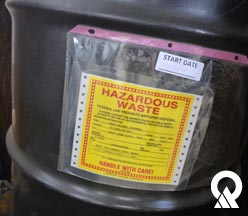By Alex Pashley
Almost everything we do creates some kind of waste. While many wastes are relatively benign, some are hazardous and need to be regulated to protect public health and the environment. As a hazardous waste inspector for the Department of Environmental Quality’s Division of Solid and Hazardous Waste (DSHW), I evaluate the hazardous waste management and disposal practices of facilities that generate these wastes.

Solid waste is defined as anything you throw away, abandon, discard, or recycle. Hazardous waste is solid waste that also meets certain additional criteria. The Environmental Protection Agency (EPA) identifies specific wastes that it considers hazardous and places them on an agency list. These wastes are considered Listed Wastes and are produced by common industry and manufacturing processes, specific industries, or discarded chemical products. Wastes that are not on the EPA list may still be considered hazardous if they possess one of the following four characteristics:
Many of us don’t realize that common business processes produce hazardous waste. Some of the types of facilities and businesses that generate hazardous waste include:

- Dry cleaners
- Laboratories
- Auto-body and vehicle-maintenance shops
- Printing
- Painting
- Metal plating
- Military facilities
- Aerospace manufacturing
- Medical-device manufacturing
- Pharmacies
Not all facilities produce the same amount of waste, so hazardous waste generators are categorized based on the amount of hazardous waste they produce each month and are regulated accordingly. Large Quantity Generators (LQG) generate more than 2,200 pounds per month, Small Quantity Generators (SQG) generate between 220 pounds and 2,200 pounds per month, and Conditionally Exempt and Small Quantity Generators (CESQG) generate less than 220 pounds per month. The more waste a facility generates, the more tightly it is regulated.
We have approximately 163 LQGs and about 278 SQGs in Utah. CESQG generators are not required to obtain an EPA ID number for tracking purposes, so we don’t know exactly how many there are, but we estimate that there are a few thousand CESQG generators in the state.
Inspections are an important part of our job. Large-quantity generators are held to a higher standard than smaller generators because it’s expected that they will know and comply with the rules. Some smaller generators may not have that same knowledge or experience with waste regulations, so we perform two types of inspections for small quantity generators:
- Compliance Assistance Visits (CAVs)
- Compliance Evaluations Inspections (CEI)
Compliance assistance visits provide us with an opportunity to educate businesses on the proper management of hazardous waste without fear of an enforcement action. After we’ve talked with a generator about appropriate waste management practices during a CAV, we follow it up with a Compliance Evaluation Inspection (CEI). At this point, we expect the business to be in compliance. If we find violations during a CEI, we may take enforcement actions.

The good news is that over the last few years the number of large and small hazardous waste generators has dropped. Many facilities are engaging in waste minimization through pollution prevention practices and waste recycling. Switching to nonhazardous materials reduces or eliminates generation of hazardous waste during the production process, and recycling reclaims the value of waste products like solvents or paints. Waste minimization saves businesses money by reducing waste management costs, lowering raw material costs, and improving production efficiency.
We won’t ever be able to completely eliminate hazardous wastes, but pollution prevention and recycling practices will help reduce the volume of hazardous wastes and reduce our risk of harm from these substances.
You can do your part to reduce hazardous waste. Household hazardous wastes include antifreeze, pesticides, paints, batteries, used oil, and solvents. Common household products that contain hazardous materials can pose a risk to human health and the environment, particularly if they are handled improperly. What can you do? Use the smallest amount of these products that you need to get the job done, or better yet, choose nonhazardous alternatives! If you have household hazardous wastes and aren’t sure how to dispose of them properly, check out our webpage for household waste collection events and facilities and businesses that accept this waste year-round.

I’ve been with DEQ for almost 29 years. I spent my first few years with the Underground Storage Tank program. Since then, I’ve been with DSHW as an inspector and have overseen the cleanup of petroleum- and hazardous-waste contaminated sites. On my time off, I enjoy being on a river somewhere rafting or fly-fishing. I also enjoy riding my bike or motorcycle and getting out for a good day of skiing.

